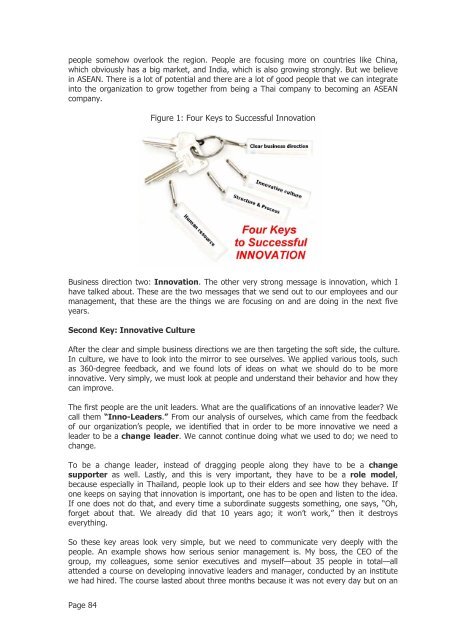Knowledge Management: From Brain to Business (PDF 5.5 - Asian ...
Knowledge Management: From Brain to Business (PDF 5.5 - Asian ...
Knowledge Management: From Brain to Business (PDF 5.5 - Asian ...
You also want an ePaper? Increase the reach of your titles
YUMPU automatically turns print PDFs into web optimized ePapers that Google loves.
people somehow overlook the region. People are focusing more on countries like China,<br />
which obviously has a big market, and India, which is also growing strongly. But we believe<br />
in ASEAN. There is a lot of potential and there are a lot of good people that we can integrate<br />
in<strong>to</strong> the organization <strong>to</strong> grow <strong>to</strong>gether from being a Thai company <strong>to</strong> becoming an ASEAN<br />
company.<br />
Page 84<br />
Figure 1: Four Keys <strong>to</strong> Successful Innovation<br />
<strong>Business</strong> direction two: Innovation. The other very strong message is innovation, which I<br />
have talked about. These are the two messages that we send out <strong>to</strong> our employees and our<br />
management, that these are the things we are focusing on and are doing in the next five<br />
years.<br />
Second Key: Innovative Culture<br />
After the clear and simple business directions we are then targeting the soft side, the culture.<br />
In culture, we have <strong>to</strong> look in<strong>to</strong> the mirror <strong>to</strong> see ourselves. We applied various <strong>to</strong>ols, such<br />
as 360-degree feedback, and we found lots of ideas on what we should do <strong>to</strong> be more<br />
innovative. Very simply, we must look at people and understand their behavior and how they<br />
can improve.<br />
The first people are the unit leaders. What are the qualifications of an innovative leader? We<br />
call them “Inno-Leaders.” <strong>From</strong> our analysis of ourselves, which came from the feedback<br />
of our organization’s people, we identified that in order <strong>to</strong> be more innovative we need a<br />
leader <strong>to</strong> be a change leader. We cannot continue doing what we used <strong>to</strong> do; we need <strong>to</strong><br />
change.<br />
To be a change leader, instead of dragging people along they have <strong>to</strong> be a change<br />
supporter as well. Lastly, and this is very important, they have <strong>to</strong> be a role model,<br />
because especially in Thailand, people look up <strong>to</strong> their elders and see how they behave. If<br />
one keeps on saying that innovation is important, one has <strong>to</strong> be open and listen <strong>to</strong> the idea.<br />
If one does not do that, and every time a subordinate suggests something, one says, “Oh,<br />
forget about that. We already did that 10 years ago; it won’t work,” then it destroys<br />
everything.<br />
So these key areas look very simple, but we need <strong>to</strong> communicate very deeply with the<br />
people. An example shows how serious senior management is. My boss, the CEO of the<br />
group, my colleagues, some senior executives and myself—about 35 people in <strong>to</strong>tal—all<br />
attended a course on developing innovative leaders and manager, conducted by an institute<br />
we had hired. The course lasted about three months because it was not every day but on an
















